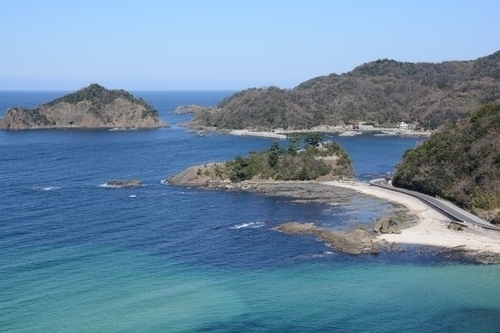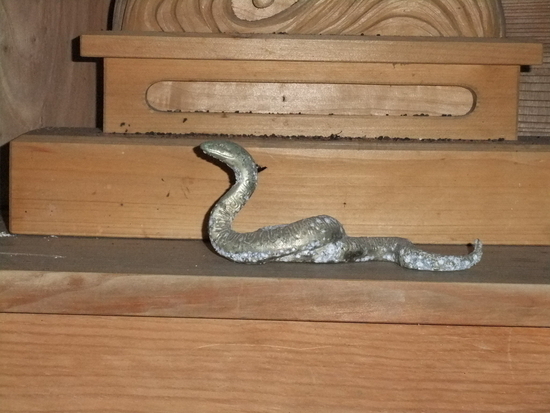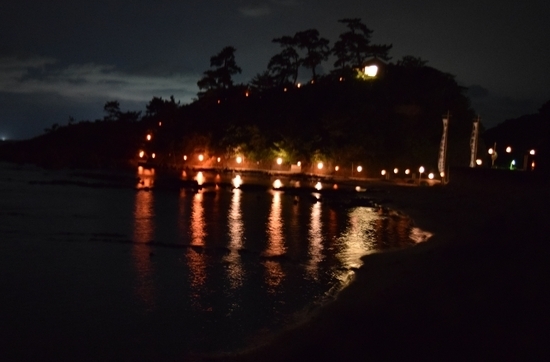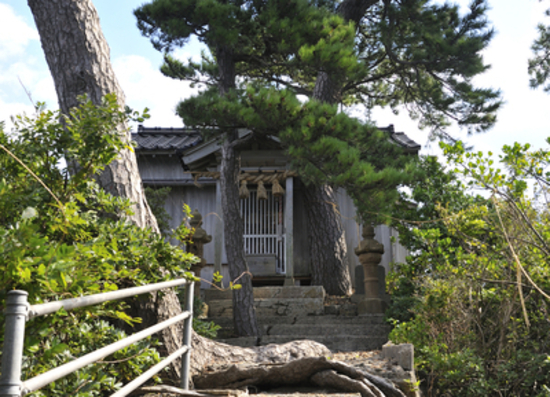Souzu-ura
| Bay Name | Souzu-ura |
|---|---|
| Shrine Name |
(Former) Sanjya Daimyojin (Present)Meijima jinja |
| Deity | Watasumi no mikoto |
| Location |
Matsue-shi Mihonoseki machi Shichirui Aza Meijima |
Souzu ura sanja daimyoujin
Minatoda wo moruya Souzu no urakaze ni
Aki no honami no nabikutozo miru

The Souzu as written in the poem is mentioned in the Unyoshi within the Katae Bay entry as, "This bay contains the places Souzu and Tamae.", but to be specific, it is located to the east of Katae Bay close to Shichirui Bay. It is likely the daily life of the residents is more closely related to Shichirui than to Katae. The shrine in Souzu, Meijima, in present times is on land, but the fact the name Meijima contains 'shima' (island), leads to the conclusion that the shrine was formerly found on an island.
These days, Meijima shrine is enshrined within the precincts of Shichirui shrine, but its main shrine hall is all in order and its regular festival continues to be held. The enshrined deity is Watasumi no Mikoto.
There is no information from the time of the 42-bay pilgrimage about the shrine name Sanjya Daimyoujin, so a blank is drawn about what relation it may have to Meijima shrine. This issue still requires investigating, but there is a 'Sanja' location to be found south of the coastline near Meijima Shrine. There are no other connection points with shrines in the south area. According to local folklore, there is a cave in Mabura, Nishiiwaya that enshrines the deity Mizuho zinushi no kami.

Meishima shrine is enshrined on a small island almost like a mirage on the open sea when viewed from the prefectural road at the entrance to Tamae Bay.
The small building on the island can be seen from the bridge going along the coast. Come off this road and head up to the little island and you will see a picture of 'Meijima shrine' in the middle of that building.
This little island housing the structure had a square up to 1972. Here on every first day of the eighth lunar month, to celebrate the Hassaku Festival, trainee sumo wrestlers from Honjo in Matsue and Minato Sakai in Tottori prefecture would come to perform a dedicatory sumo bout within the shrine precincts. Youngsters could also participate for prizes such as school supplies, no doubt making it a fun event indeed. Now, all the earth and sand have been washed away by typhoons leaving only rock .For a while, children would do sumo in the shrine's hall of worship, but that structure is no longer standing.
Even now, every September 1st, the shrine's traditional festival goes ahead. The 'Yoimiya', pre festival held the evening before on August 31st ,sees lanterns lit and placed from the beach to the shrine entrance, lighting up the whole island in a spectacular fashion.
The Hassaku Festival has its origins in agriculture- a ritual asking for a bountiful harvest with the main deity being the kami (god) of sea travel.
The shrine itself is home to a snake figurine that symbolizes the dragon said to be the guardian of the seas. A Shinto priest who has seen this reported it as being quite a terrifying image. After being granted a viewing by the authorities, this author can vouch that seeing it in person surpasses everything that I heard beforehand and is a spirit of a deity capable of haunting one's dreams.
Going back around 20 years. a meteorite fell onto a residence near Meijima shrine. The meteorite was 25 cm x 14 cm and weighed 6 kilograms. A memorial replica is on display near the house in question, but the real thing can be seen on the 4th floor of the Meteor Plaza at Shichiura port on the east of Souzu Bay. This 'traveler' from another universe which penetrated the two-storey house caused no injuries and is itself displayed undamaged.


| Bay Name | Souzu-ura |
|---|---|
| Shrine Name |
(Former) Sanjya Daimyojin (Present)Meijima jinja |
| Deity | Watasumi no mikoto |
| Location |
Matsue-shi Mihonoseki machi Shichirui Aza Meijima |
Souzu ura sanja daimyoujin
Minatoda wo moruya Souzu no urakaze ni
Aki no honami no nabikutozo miru
The Souzu as written in the poem is mentioned in the Unyoshi within the Katae Bay entry as, "This bay contains the places Souzu and Tamae.", but to be specific, it is located to the east of Katae Bay close to Shichirui Bay. It is likely the daily life of the residents is more closely related to Shichirui than to Katae. The shrine in Souzu, Meijima, in present times is on land, but the fact the name Meijima contains 'shima' (island), leads to the conclusion that the shrine was formerly found on an island.
These days, Meijima shrine is enshrined within the precincts of Shichirui shrine, but its main shrine hall is all in order and its regular festival continues to be held. The enshrined deity is Watasumi no Mikoto.
There is no information from the time of the 42-bay pilgrimage about the shrine name Sanjya Daimyoujin, so a blank is drawn about what relation it may have to Meijima shrine. This issue still requires investigating, but there is a 'Sanja' location to be found south of the coastline near Meijima Shrine. There are no other connection points with shrines in the south area. According to local folklore, there is a cave in Mabura, Nishiiwaya that enshrines the deity Mizuho zinushi no kami.
Meishima shrine is enshrined on a small island almost like a mirage on the open sea when viewed from the prefectural road at the entrance to Tamae Bay.
The small building on the island can be seen from the bridge going along the coast. Come off this road and head up to the little island and you will see a picture of 'Meijima shrine' in the middle of that building.
This little island housing the structure had a square up to 1972. Here on every first day of the eighth lunar month, to celebrate the Hassaku Festival, trainee sumo wrestlers from Honjo in Matsue and Minato Sakai in Tottori prefecture would come to perform a dedicatory sumo bout within the shrine precincts. Youngsters could also participate for prizes such as school supplies, no doubt making it a fun event indeed. Now, all the earth and sand have been washed away by typhoons leaving only rock .For a while, children would do sumo in the shrine's hall of worship, but that structure is no longer standing.
Even now, every September 1st, the shrine's traditional festival goes ahead. The 'Yoimiya', pre festival held the evening before on August 31st ,sees lanterns lit and placed from the beach to the shrine entrance, lighting up the whole island in a spectacular fashion.
The Hassaku Festival has its origins in agriculture- a ritual asking for a bountiful harvest with the main deity being the kami (god) of sea travel.
The shrine itself is home to a snake figurine that symbolizes the dragon said to be the guardian of the seas. A Shinto priest who has seen this reported it as being quite a terrifying image. After being granted a viewing by the authorities, this author can vouch that seeing it in person surpasses everything that I heard beforehand and is a spirit of a deity capable of haunting one's dreams.
Going back around 20 years. a meteorite fell onto a residence near Meijima shrine. The meteorite was 25 cm x 14 cm and weighed 6 kilograms. A memorial replica is on display near the house in question, but the real thing can be seen on the 4th floor of the Meteor Plaza at Shichiura port on the east of Souzu Bay. This 'traveler' from another universe which penetrated the two-storey house caused no injuries and is itself displayed undamaged.






